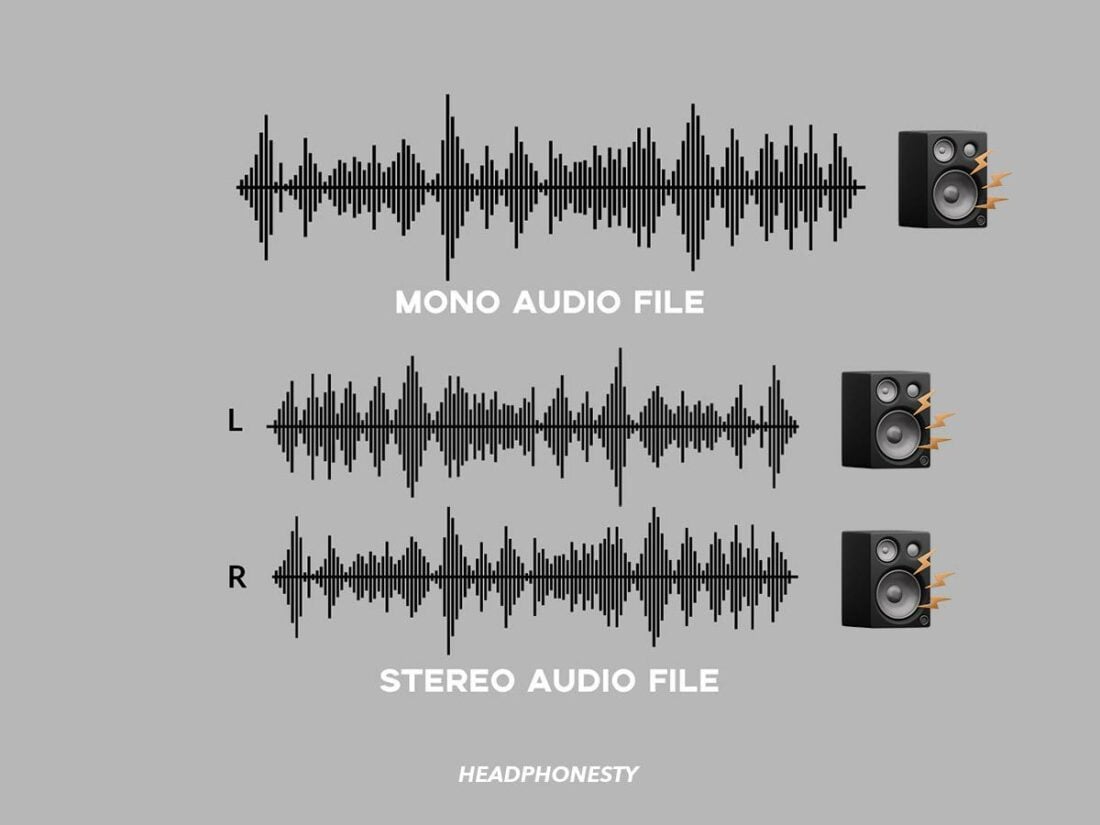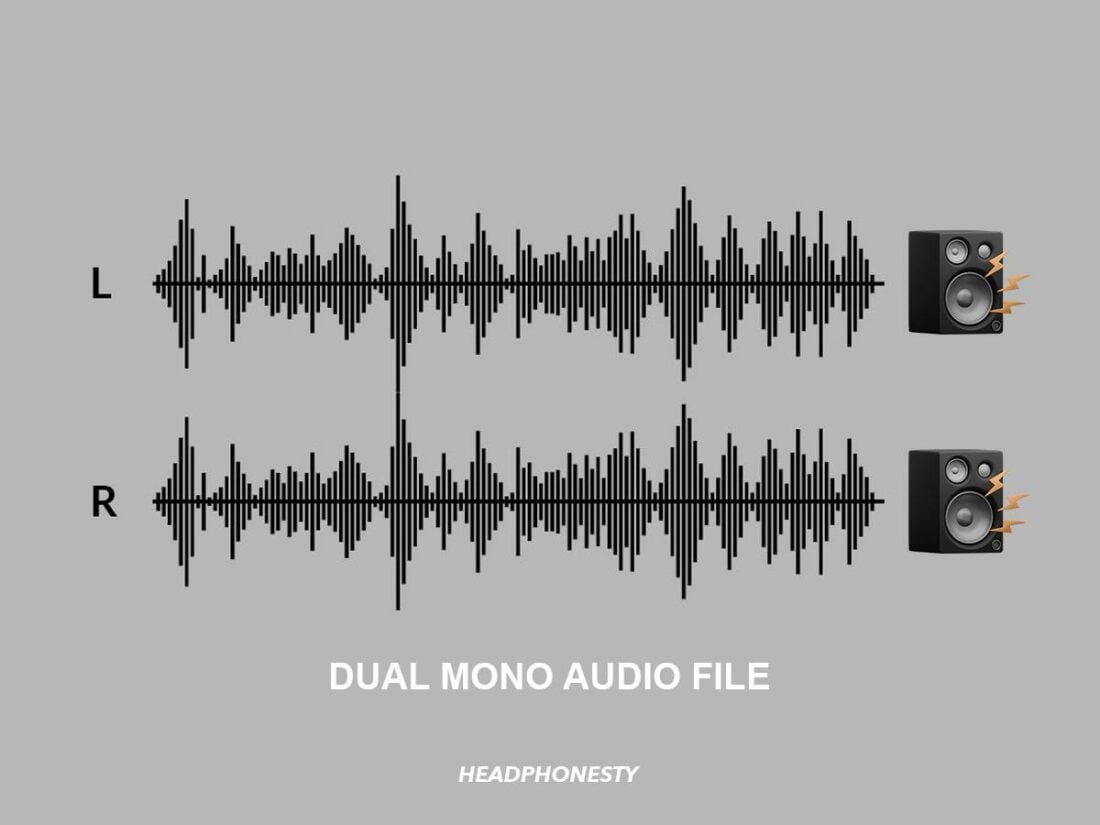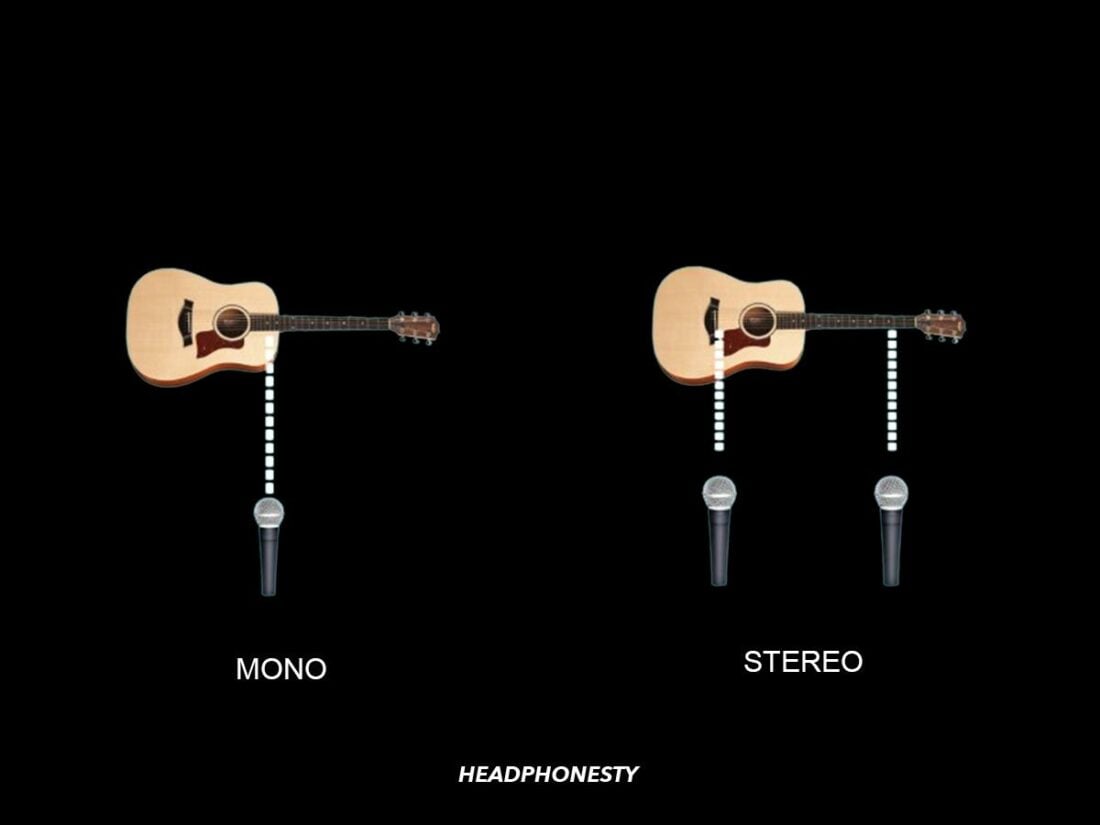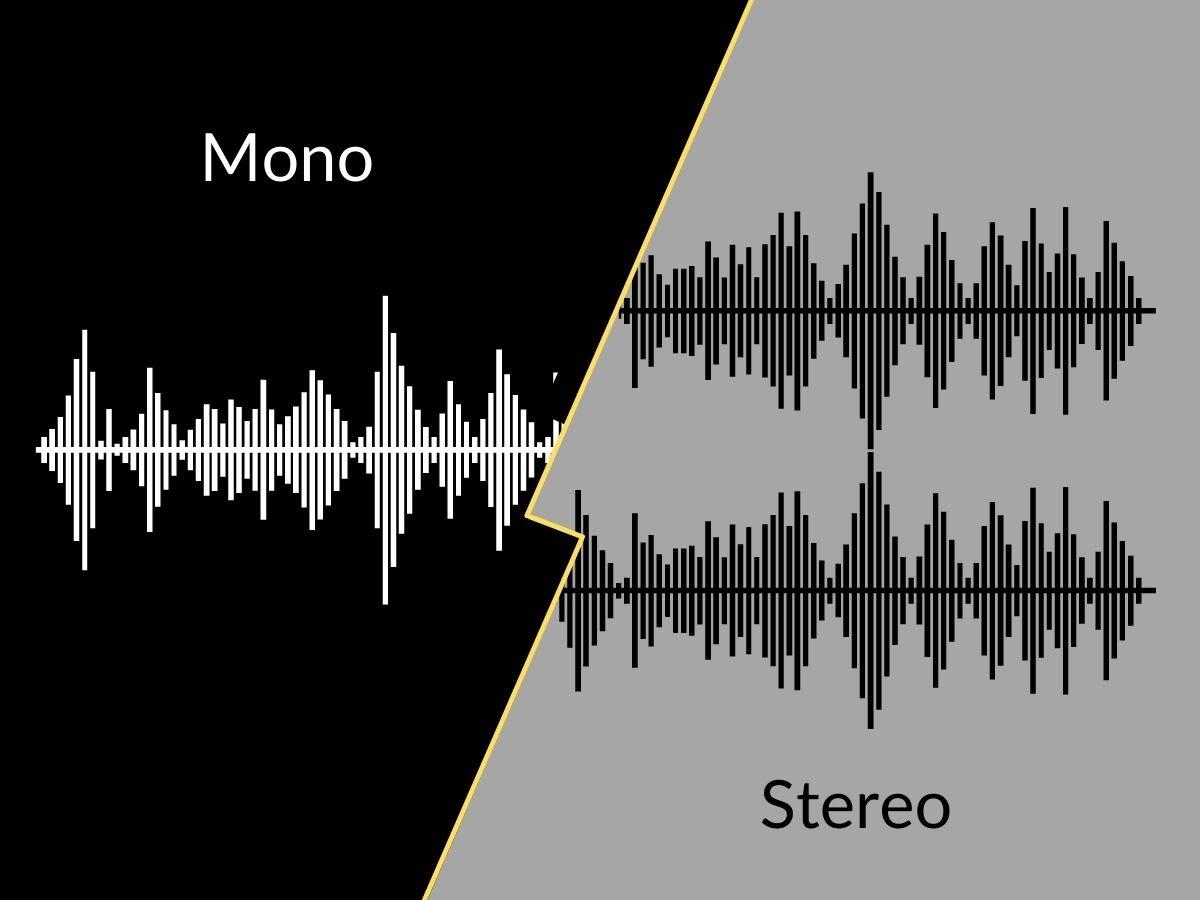Here’s our beginner’s guide on mono and stereo formats, playback, and recording.
These days, nearly all media is formatted for stereo playback, making it easy to hit “play” without asking any further questions.
But if you’re new to recording, you’re now presented with the option of recording in mono or stereo. It might be your first time needing a clear answer to the simple yet sometimes convoluted question: what is the difference between mono and stereo?
We’ll detail those differences as they apply to file format, playback, and recording below.
Differences Between Mono vs. Stereo Audio
The difference between mono and stereo audio comes down to the different number of audio channels used in each format. Mono formats use just one channel, while stereo formats use two channels (typically arranged as a left and a right channel).
Let’s take a look at the waveform view of mono and stereo audio files to get a better sense of what this means:

As we can see, the mono audio file contains just one waveform for single-channel playback out of one speaker. On the other hand, the stereo file contains two separate channels that can be respectively output through two separate speakers.
What mono and stereo audio sound like
The different number of audio channels in mono and stereo results in substantially distinct listening experiences between the two formats.
With independent left and right channels, stereo audio is able to convey a multi-dimensional audio field between the points of left and right speakers. This allows a listener to gradationally localize sounds between left and right audio channels.
With two points of audio output, stereo fields can also introduce illusions of depth in their playback via timing and frequency cues that our brains interpret as spatial information. The sum of spatial information conveyed by a stereo field produces what we call a stereo image or a soundstage.
Mono audio has a more “squished” sound than stereo due to its inherent one-channel limitation. With all audio being summed into a single channel and output through a single speaker, mono does not create the gradient of left and right sound localization enabled by stereo. Consequently, it lacks the spatial character we hear in stereo audio.
You can hear the difference between mono and stereo for yourself by listening to the files below.
What Is Dual Mono?
Dual mono, sometimes called mirrored mono, reformats a mono signal for stereo playback. This is achieved by duplicating the single audio channel of a mono file and playing it back on the left and right audio channels. Let’s see how a dual mono file compares to mono and stereo files in a waveform view:

We can see the following in the above visual:
- The mono file contains one channel of audio.
- The stereo file contains two channels of audio that are different from one another.
- The dual mono file contains two channels of audio that are identical to one another.
As the vast majority of headphones and speaker setups are stereo, mono audio is usually transmitted and experienced in dual mono (to the bane of everyone trying to understand the difference between mono and stereo).
You probably get the idea of what dual mono sounds like, but in case you don’t, check out the dual mono sample below:
Differences Between Mono vs. Stereo Recording
As mono contains just one audio channel, mono audio is recorded using just one microphone. Ostensibly, stereo recording requires two (or more) microphones to fulfill its two audio channels.

Nearly every stereo recording contains some parts that were recorded in mono, and some that were recorded in stereo. Vocals, for example, are usually recorded in mono as the sound source is focused on a single point (the singer’s mouth).
Instruments like acoustic guitars and pianos, however, are often recorded in stereo. This is done to capture the unique timbral details that occur at different physical points on the instrument.
Mono and stereo recordings also differ in how they achieve their center image.
A single-channel mono recording appears centered when the track’s pan pot is centered.
A stereo recording appears centered when the two audio channels pan to the left and right.
Mixing mono into stereo: pseudo-stereo
If you’ve recorded something in mono but want some extra stereo dimension, applying a pseudo stereo mixing technique (sometimes called fake stereo) is the way to go. Pseudo-stereo refers to altering just one of the two identical channels in a dual mono format.
By altering only one of the channels, the two channels become audibly distinct from one another, like they are in a stereo recording. The changes you make to the single audio channel are entirely up to you – EQ, compression, delay, or whatever else.
To hear just how drastically a pseudo-stereo mixing technique can expand a dual-mono sound, I recommend applying a 15-millisecond delay to one of the mono audio channels of something you’ve recorded and formatted as dual mono (see above note). Check out the effect this produces below by comparing it to the dual mono recording:
Frequently Asked Questions
- Is music in mono or stereo?
- Are phone speakers mono or stereo?
- What is merged stereo?
- When was stereo audio invented?
Is music in mono or stereo?
The majority of modern music is in a stereo format. Whether or not you hear it in mono or stereo depends on whether you’re listening to it with one or two speakers.
Are phone speakers mono or stereo?
Many phones feature just one speaker and thus playback audio in mono. More recent phone models, like those from the Google Pixel series, have started incorporating two speakers and thus enable stereo playback.
What is merged stereo?
Merged stereo refers to stereo audio files that are played through a mono output.
When was stereo audio invented?
Modern stereo was invented in 1933 by the British engineer Alan Blumein.

Dobrý den
Chtěl bych se zeptat, jaký zvuk vychází z party reproduktoru? Děkuji
This article is of great benefit to me; I have been using mono on listening to music and movies on my phone. Although I have set it to stereo but this article still enlightened me to know more about mono and stereo, thank you.
Happy to help, and thank you too for reading!
What am I missing in the sound effects when I use dual mono instead of stereo?
Thanks so much 🙂 This was very helpful!
Kind Regards, Sadie, aka Mellowatts
Also, if you listen to a lot of music from the 1960s on back, much of the energy in production of the music was done in the mono mix since most people were primarily listening to the music on AM radio while stereo was mainly listened to a home on console hi-fi’s or high end audio equipment and the stereo was often an afterthought. Much of the best stereo in the 50s-60s as it originally came out was done mostly in easy listening, jazz, classical, country music mostly listened to by adults, etc. and was heard on LPs. If they didn’t mix the recording in stereo or if they were from the time that mono recording was all there was, the record labels did different techniques to fake stereo from the mono recording to make the additional dollar in sales or in the case of stuff recorded in 2-track, the vocals were in 1 channel and the instruments are in the other channel. FM stereo had its infancy in the late 1960s where stations either had stereo MOR and jazz stations, automated easy listening instrumental music stations (a.k.a. Beautiful Music, playing stuff such as Roger Williams, Bert Kaempfert, Lawrence Welk, Percy Faith, etc. in stereo whenever possible) and starting mostly in the 1970s with some areas starting in 1967-1968, freeform stereo album rock music playing full length album versions rather than the singles played on AM Top 40 stations. Stereo albums were a dollar more than the mono and in a huge majority of the time, they were dedicated mixes. There are even many instances where the 45s are of different recordings from the album sessions.